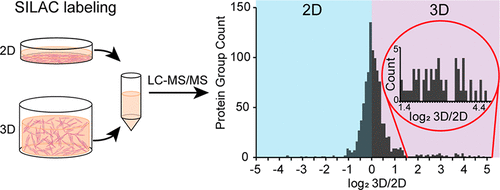当前位置:
X-MOL 学术
›
J. Proteome Res.
›
论文详情
Our official English website, www.x-mol.net, welcomes your
feedback! (Note: you will need to create a separate account there.)
Three-Dimensional Cell Culture Conditions Affect the Proteome of Cancer-Associated Fibroblasts
Journal of Proteome Research ( IF 3.8 ) Pub Date : 2018-07-23 , DOI: 10.1021/acs.jproteome.8b00237 Regine C. Tölle 1, 2, 3 , Cedric Gaggioli 4 , Jörn Dengjel 1, 2
Journal of Proteome Research ( IF 3.8 ) Pub Date : 2018-07-23 , DOI: 10.1021/acs.jproteome.8b00237 Regine C. Tölle 1, 2, 3 , Cedric Gaggioli 4 , Jörn Dengjel 1, 2
Affiliation

|
In vitro cell culture systems are an invaluable tool for cell biological research to study molecular pathways and to characterize processes critical in human pathophysiology. However, the experimental conditions in two-dimensional (2D) cell cultures often differ substantially from the in vivo situation, which continuously raises concerns about the reliability and conferrability of the obtained results. Three-dimensional (3D) cell cultures have been shown to closer mimic in vivo conditions and are commonly employed, for example, in pharmacological screens. Here, we introduce a 3D cell culture system based on a mixture of collagen I and matrigel amenable to stable isotope labeling by amino acids in cell culture (SILAC) and quantitative mass spectrometry-based proteomics analyses. We study the extra- and intracellular proteomic response of skin fibroblast isolated from healthy volunteers in comparison to cancer-associated fibroblasts (CAF) on 3D culture conditions. Both, control cells and CAF, change their proteomic composition based on the culture conditions. Critically, cell type differences observed in 2D are often not preserved in 3D, which commonly closer resemble phenotypes observed in vivo. Especially, extracellular matrix and plasma membrane proteins are differentially regulated in 2D versus 3D.
中文翻译:

三维细胞培养条件影响癌症相关的成纤维细胞的蛋白质组。
体外细胞培养系统是进行细胞生物学研究以研究分子途径并表征对人类病理生理至关重要的过程的宝贵工具。但是,二维(2D)细胞培养中的实验条件通常与体内情况大不相同,这不断引起人们对所获得结果的可靠性和可传递性的担忧。三维(3D)细胞培养物已显示出更接近于体内的模拟条件,并且通常在例如药理学筛选中使用。在这里,我们介绍一种基于胶原I和基质胶的混合物的3D细胞培养系统,该混合物可通过细胞培养(SILAC)中的氨基酸进行稳定的同位素标记,并基于定量质谱分析蛋白质组学进行分析。我们研究了在3D培养条件下与癌症相关的成纤维细胞(CAF)相比,从健康志愿者中分离出的皮肤成纤维细胞的细胞外和细胞内蛋白质组学反应。对照细胞和CAF都根据培养条件改变其蛋白质组学组成。至关重要的是,在2D模式下观察到的细胞类型差异通常不会保留在3D模式下,通常与体内观察到的表型更相似。特别是,细胞外基质和质膜蛋白在2D与3D中受到差异调节。
更新日期:2018-07-24
中文翻译:

三维细胞培养条件影响癌症相关的成纤维细胞的蛋白质组。
体外细胞培养系统是进行细胞生物学研究以研究分子途径并表征对人类病理生理至关重要的过程的宝贵工具。但是,二维(2D)细胞培养中的实验条件通常与体内情况大不相同,这不断引起人们对所获得结果的可靠性和可传递性的担忧。三维(3D)细胞培养物已显示出更接近于体内的模拟条件,并且通常在例如药理学筛选中使用。在这里,我们介绍一种基于胶原I和基质胶的混合物的3D细胞培养系统,该混合物可通过细胞培养(SILAC)中的氨基酸进行稳定的同位素标记,并基于定量质谱分析蛋白质组学进行分析。我们研究了在3D培养条件下与癌症相关的成纤维细胞(CAF)相比,从健康志愿者中分离出的皮肤成纤维细胞的细胞外和细胞内蛋白质组学反应。对照细胞和CAF都根据培养条件改变其蛋白质组学组成。至关重要的是,在2D模式下观察到的细胞类型差异通常不会保留在3D模式下,通常与体内观察到的表型更相似。特别是,细胞外基质和质膜蛋白在2D与3D中受到差异调节。











































 京公网安备 11010802027423号
京公网安备 11010802027423号